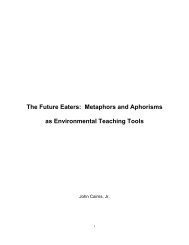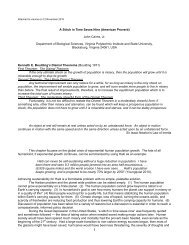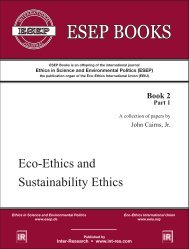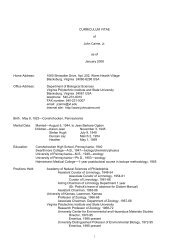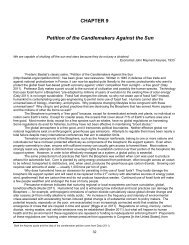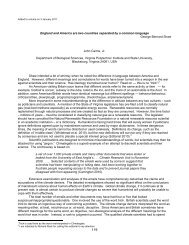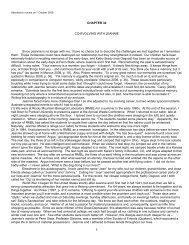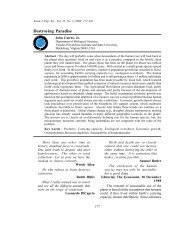View - ResearchGate
View - ResearchGate
View - ResearchGate
You also want an ePaper? Increase the reach of your titles
YUMPU automatically turns print PDFs into web optimized ePapers that Google loves.
Article 30261ECOLOGICAL FOOTPRINTSThe average ecological footprint of a North American (essentially the amount of land that wouldbe necessary to support a defined economy sustainably at its current material standard of living) is4 to 5 hectares (Wackernagel & Rees 1996). At a 2 % annual human population growth rate, 8 to10 hectares would be need in 35 years to maintain the footprint size. On a finite planet, unrestrainedexponential growth is idiocy!The Netherlands (National Institute for Public Health and Environmental Protection 1992) has asmaller ecological footprint (3.32 hectares per capita) than the US and Canada, but a standard ofliving above the average for the entire planet. However, even a small population growth rate canquickly reduce the available hectares per capita. At a 1 % annual human population growth rate,the doubling time would be approximately 70 years. The ecological footprint size would be reducedto 1.66 hectares per capita in the Netherlands (and consequently a much lower standard of living)if the resource base remained constant. This situation would result in halving the per capitaresources if the resource base were not doubled. Obviously, humankind cannot send the entirepopulation ‘surplus’ to other planets during the 70-year doubling time.In stark contrast, the ecological footprint size in India is 0.38 hectares per capita (Wackernagel &Rees 1996). Worse yet, the estimated footprint size of the average person in India in the bottom50% of income earners is roughly 0.2 hectares per capita (Wackernagel & Rees 1996). Thus, thepresent condition is already unsatisfactory. If the global carrying capacity for humans is reached orexceeded on a finite planet, then consumption by the rich must be markedly reduced to shiftresources to the poor or the latter will suffer or die. This problem is one of eco-ethics, althoughnumerical data provide useful information on how much needs to be done once it is decided whatto do. Living at higher densities reduces the ecological impact because it does not require as muchland for urban sprawl and, properly managed, has a lower energy consumption. Wackernagel &Rees (1996) provide an excellent illustration of comparative ecological footprint size for traveling5 km each work day — bicycles, approximately 122 square meters/capacity; buses approximately301 square meters/capacity, and automobiles; 1,442 square meters/capacity. In addition, food isalso a major factor that determines ecological footprint size.Brown (2000) estimates 1.1 billion hungry people on the planet. Since poverty and hunger areclosely related, it should be no surprise that the World Bank (1997) estimates 1.3 billion people areliving in poverty (defined as US $1.00/day or less). The precision of these numbers is important,but, for this article, the important issues are ethical. The numbers keep changing, but the ethicalproblems are constant.The ethical question of resource distribution and allocation within the human species is of paramountimportance. Before a systematic and orderly analysis of this issue of resource limits andallocation can be made, there are three important questions for which some numbers must be producedand some ethical issues addressed. First, how much of Earth’s resources (10 %, 25 %,50 %, 75 %) must be allocated to other species (i.e. natural systems) so that sufficient natural capitaland ecosystem services remain for maintaining human society? Second, how can the size ofhumankind’s ecological footprint be adjusted to a sustainable level? Third, since there will be considerableuncertainty about both numbers, what safety factor should be used as a precautionarymeasure? Vitousek et al. (1986) have estimated that human society is co-opting approximately40 % of the photosynthetic energy of Earth (i.e. that energy converted by plants from sunlight toforms such as carbohydrates that are more suitable for use by humans). The percentage of thephotosynthetic energy for the ‘machinery’ of nature to maintain natural capital and deliver the



